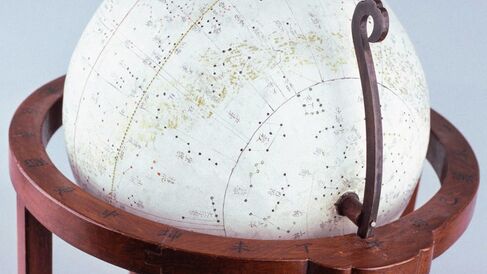Japanese Star Globe

Stars have been drawn onto the surface of this Japanese astronomical globe using different coloured inks. These colours represent the jia (houses) of traditional Chinese astronomy and indicate the maker's interest in historical aspects of the subject.
Sir Charles Wheatstone(1802-1875) was an important 19th century physicist and inventor. He had a lifelong fascination with music and acoustics and invented this beautiful instrument, the symphonium (patented in 1829), which was the precursor to his better known invention, the English concertina.
From antiquity to the present day, people have used globes to model the world around them. Globes serve many different functions, from practical tools to representations of power, and have been produced for a variety of audiences, including as children's teaching objects, sailors' navigation aids and gentlemen's status symbols.
Many of the globes held in the Whipple Museum's collection were used for teaching, including the dissectable paper globe kits designed by Edward Mogg to liven up children's geography lessons.
The Globes section of the Explore website received special funding support from the Designation Challenge Fund (Audience Development Grant), the Ann D Foundation and Dr Anita McConnell. We are very grateful for this support.
Written evidence suggests that people have used globes to model the world around them since antiquity; Strabo (63/64BCE-24CE) reported that Crates of Mallos had a globe of the equivalent of 10 feet in diameter. Globes are delicate, though, and the surviving evidence for early globe use is sparse. The earliest globe that survives today was made in 1492 by Martin Behaim, a German navigator and geographer in the employ of King João II of Portugal. Behaim's globe recorded not only the lie of the lands being discovered by seabourne explorers, but also details of overseas commodities, market places and local trading protocols. Thus, the earliest surviving globe, which probably reflects many others produced around the same time, features information on more than cartography.
The 16th century
Globes retained appeal to a wide range of audiences into the 16th century. Gemma Frisius, a Dutch cartographer, mathematician and instrument maker who worked at Louvain, wrote in his Principiis de astronomiae et cosmographiae (1530) that:
"[T]he mounted globe ... is the only one of all instruments whose frequent usage delights astronomers, leads geographers, confirms historians, enriches and improves legists [les legists], is admired by grammarians, guides pilots, in short, aside from its beauty, its form is indescribably useful and necessary for everyone."
Frisius' account of globes as beautiful as well as useful is significant - globes have tended to attract attention as art objects, as well as for their depiction of geographically, politically and economically important lands. Globes were often exchanged as gifts among important rulers, since they signified command of the world, but were also suitably stately for presentation to powerful figures.
The variety of uses to which globes could be turned is illustrated by the case of a globe made by Gerard Mercator, a Flemish cartographer who trained under Frisius. Mercator included rhumb lines on his globe of 1541, which meant that the globe could have been of some use in navigational instruction. However, Mercator made the globe for Nicolas Perrenot de Granvelle, an important figure in the privy council of Emperor Charles V. De Granvelle would have been attracted by the possibility of possessing the world symbolically by possessing the globe, and the courtly setting suggests that the beauty and grandeur of the globe would have been as important as its utility.
There are no 16th-century globes in the Whipple collection, but the objects presented here serve to demonstrate the variety of meanings that globes have attracted.
A practical instrument
We do not know who made this globe, but a Chinese inscription on the sphere tells us that the object was crafted in Tenmei yonen saiji kinoetatsu gogatsu, that is, "the fifth month of the forth year of Tenmei" (Image 1). Tenmai is the name of an era in Japan spanning the period 1781-1789, so the sphere can be identified as Japanese and dated to 1784.
The globe is less ornamental than the majority of Asian astronomical instruments that survive from the Edo period (1603-1868), such as the Japanese sundial pictured in Image 2. Stars are inked onto the paper surface, rather than being engraved on a costly metal sphere, as they would have been on courtly globes. The small size, low weight, and clarity of the characters suggest that the globe might have been used in teaching - the item could be readily carried around and the characters are easy to read. Alternatively, the globe might have been a prototype for a more luxurious instrument.
Chinese influence
The design of this globe demonstrates extensive Chinese influence. The horizon ringof the globe is marked with characters representing the twelve Chinese 'double-hours of day and night'. Chinese constellations such as the 'imperial concubine' and 'celestial emperor' were used, and represented with ball-and-stick diagrams, rather than the pictorial characters familiar from western astronomy. The dial in image 2 also shows strong Chinese influence - the hour characters around the edge of the dial are Chinese, while Japanese characters are shown in the bowl of the dial.
History in astronomy
While we tend to see astronomy as an observational science, astronomers in the Chinese tradition took a great interest in historical aspects of their subject. On the Japanese globe here, stars are inked in different colours (Image 3) to indicate in which of the three traditional Chinese jia, or "houses", of astronomy they were first recorded. Stars that can no longer be seen are also nevertheless recorded. The way that the stars are mapped on this globe suggests that the maker was interested in historically focused Chinese astronomy.
This article is based on the work of Hilary Smith, 'An Eighteenth Century Japanese Celestial Globe', submitted for the M.Phil Degree, 2000.
Katie Taylor
Katie Taylor, 'The Japanese star globe and historical astronomy', Explore Whipple Collections, Whipple Museum of the History of Science, University of Cambridge, 2009.
